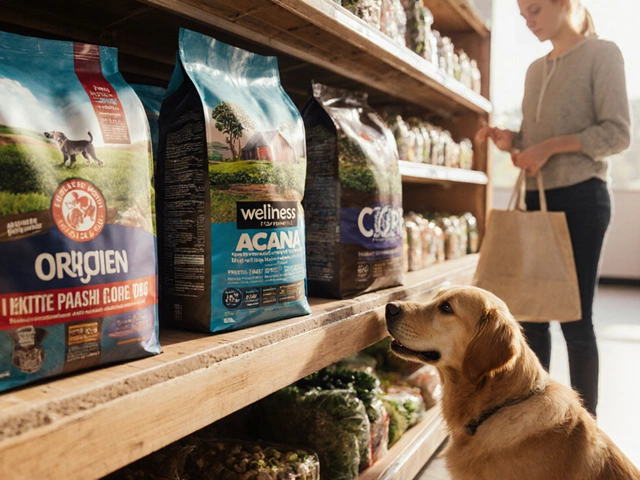Picking dog food is surprisingly stressful. The pet store aisles are packed with bright bags, exotic promises, and buzzwords like “grain-free” or “all natural.” But here’s the truth: most vets don’t care about fancy marketing. They care about what keeps your dog healthy, active, and living longer.
The real secret? There isn’t one magic brand or recipe that fits every dog. Instead, it’s about finding food with quality protein, safe ingredients, and the right balance for your dog’s age and health problems. Vets look past the advertising—they want to see named meats (like chicken or beef), whole grains or sweet potatoes for energy, and absolutely no mystery “meat by-products” or loads of fillers.
Don’t get pulled in by the latest trends before checking what science (and your vet) says. Some dogs thrive on basic dry kibble, while others might need a prescription formula or even a custom meal plan for allergies. The trick is tuning into what’s actually in the bag, not just how pretty the packaging looks.
- What Vets Look for in Dog Food
- Dry vs Wet vs Fresh: Pros and Cons
- Top Vet-Recommended Dog Food Brands (2025)
- How to Read a Dog Food Label
- Debunking Grain-Free and Raw Diet Myths
- Easy Tips for Healthier Mealtimes
What Vets Look for in Dog Food
So, what actually matters when picking the best dog food for your furry friend? Most vets go straight to the ingredients list before anything else. They look for real, whole protein sources up front—think chicken, beef, or fish named specifically, not just "meat meal." Dogs need quality protein to keep their muscles strong and energy up.
Carbs aren’t the enemy either. Vets usually want to see healthy sources like whole grains (brown rice, oats) or sweet potatoes high on the list. Carbs give dogs the energy boost they need for walks, play, and zoomies. Cheap fillers like corn gluten meal or soybean hulls are a red flag; they’re mainly there to bulk up the food, not nourish your pup.
Fat content is important too. Healthy fats from sources like chicken fat or fish oil help keep your dog’s coat shiny and support brain health. Plus, you want a clear source of fat listed, not something vague like "animal fat."
Don’t forget vitamins and minerals. Good dog nutrition means everything’s balanced—calcium for bones, vitamin E for the immune system, and more. If you see “complete and balanced” on the label and it says it meets AAFCO (Association of American Feed Control Officials) standards, you’re usually in good shape. That means the formula has gone through feeding trials or lab tests.
- Nutritional adequacy: Choose foods that meet AAFCO standards for your dog’s age (puppy, adult, senior).
- Transparency: Companies that clearly state what’s in their food (no mystery meats!) earn big vet points.
- Breed or health special needs: Some dogs need special formulas—low-fat for pancreatitis, or limited ingredients for allergies.
- Recent recalls or manufacturing history: Vets will often suggest brands with a strong track record for quality control, not just flashy marketing.
Just to give you an idea how a balanced bowl compares, here’s a quick look at what typical dry dog food should contain:
| Nutrient | Typical Amount (%) |
|---|---|
| Protein | 18-30% |
| Fat | 8-18% |
| Fiber | 2-5% |
The bottom line? Vet recommended dog food isn’t about gimmicks. Focus on named proteins, balanced nutrients, and a trustworthy company, not whatever's trending on social media.
Dry vs Wet vs Fresh: Pros and Cons
Walk down the dog food aisle and you’ll see three big choices: dry (kibble), wet (cans or pouches), and fresh (refrigerated or delivered meals). So what’s really best for your pup? Turns out, each option has its pros and cons—and vets see all three in their clinics.
- Kibble (dry dog food) usually wins for convenience and price. It’s easy to store, has a long shelf life, and most commercial dog nutrition brands balance nutrients well. Plus, the crunch can help scrape away plaque, giving your dog’s teeth a little extra support. The downside? Some picky eaters can turn their nose up, and cheap kibble sometimes skimps on meat for fillers.
- Wet food is a lifesaver for dogs who don’t drink much water thanks to its high moisture content. The smell and soft texture appeal to senior dogs or those with dental problems. But you pay more per meal and open cans spoil fast—no big-bag savings here. Check labels, too, since some brands sneak in extra fat or salt to boost taste.
- Fresh food feels like the gold standard—think gently cooked meats and veggies right from your fridge or a delivery box. It’s a growing trend and can help with food allergies since you control the ingredients. Most fresh foods are free from heavy processing and artificial stuff. But be ready to pay up, since this style costs two to four times more than dry or canned. It also means fridge space and regular deliveries.
| Food Type | Price Range |
|---|---|
| Kibble | $0.50 – $1.00 |
| Wet | $1.50 – $3.00 |
| Fresh | $3.00 – $7.00 |
Your vet will look at your dog’s age, dental health, allergies, weight, and even how picky they get at mealtime before recommending a vet recommended food type. For most healthy adult dogs, dry or wet food works just fine as long as it’s balanced. Fresh is awesome if you have the budget and the time, but it’s not an absolute must for most pets. Always pick a recipe that matches your dog’s life stage and check with your vet if you’re thinking about switching things up—especially if your dog has chronic health issues or digestive problems.
Top Vet-Recommended Dog Food Brands (2025)
Walking into a pet store, you’ve probably seen brands shouting for attention everywhere. But if you ask a couple of vets, they’ll quickly narrow down the list to just a handful of tried-and-true picks. These best dog food brands make the cut because they spend real money and time on nutrition research, rigorous testing, and balancing every bowl for health—no guessing games.
Here’s a quick rundown of the brands that keep showing up on vet recommendation lists in 2025:
- Hill’s Science Diet – This one pops up in vet clinics all over the place. Hill’s puts serious science into every bag, and their foods offer formulas for every age and health concern. Ever see “Prescription Diet” on the shelf? That’s a go-to for medical issues like kidney or digestive problems.
- Royal Canin – Big on customizing recipes based on breed, size, and even health quirks. Vets like Royal Canin because they back up their claims with actual clinical research—not just slick ads.
- Purina Pro Plan – Not flashy, but really reliable. Purina has a whole team of nutritionists and does decades-long studies. They’ve got options for puppies, seniors, sensitive tummies—you name it.
- Eukanuba – Often recommended for active or working dogs because it nails the right balance of protein and fat. Their products are also great if you’re raising a new pup or have a large breed on your hands.
- Iams – Affordable and easy to find, Iams sticks to the basics of good dog nutrition. Vets appreciate that these recipes are straightforward and avoid ingredients dogs don’t need.
Wondering what sets these brands apart from trendy boutique foods or “raw” diets? It’s all about quality control and proven nutrition. These companies test batches for safety, track nutrient levels, and run feeding trials. That means when a vet says a food is healthy, it’s not just a guess—it’s backed up by real science.
Check out this quick comparison table to see why these brands keep showing up as vet recommended choices in dog nutrition:
| Brand | Pros | Targeted Options |
|---|---|---|
| Hill's Science Diet | Breed/condition specific, vet-trusted | Puppies, seniors, prescription |
| Royal Canin | Customized nutrition, scientific research | Breed size, allergies, weight |
| Purina Pro Plan | Affordable, wide range | All life stages, professional formulas |
| Eukanuba | Active/working dogs, healthy joints | Sporting, puppies, large breeds |
| Iams | Budget-friendly, meets AAFCO standards | Puppies, adults, seniors |
Remember, the best dog food is the one your pup does well on and enjoys eating. If you’ve got a dog with an allergy, a medical issue, or a super picky eater, talk with your vet—they’ll help you tweak the choice even further. Don’t fall for hype—stick to what works and what’s proven safe.

How to Read a Dog Food Label
Dog food labels look confusing on purpose. Brands want you to get distracted by marketing claims instead of checking what actually goes in the bowl. But if you know where to look, you can spot healthy food for your pup, just like best dog food choices vets trust.
Start with the ingredient list. Ingredients are listed from most to least by weight. If a real, named animal—like chicken, salmon, or beef—is first, that’s a good sign. Watch out for vague words like "meat meal" or "animal by-product". Those usually mean lower quality leftovers and sometimes stuff you wouldn’t want your dog eating.
Next, check the guaranteed analysis panel—that’s the box that tells you the food’s protein, fat, fiber, and moisture percentages. For most adult dogs, a crude protein between 18-30% is common, but puppies and very active dogs do better with a bit more.
| Nutrient | Average for Adult Dogs | AAFCO Recommended Minimum |
|---|---|---|
| Protein | 22% | 18% |
| Fat | 12% | 5.5% |
| Fiber | 4% | --- |
Also look for a statement from AAFCO (Association of American Feed Control Officials). If the bag says the food is "complete and balanced" for your dog's life stage, that's your sign it covers basic nutritional needs. If you spot terms like "for intermittent or supplemental feeding only," it’s not meant for daily meals.
- Healthy dog diet tip: Spot lots of unpronounceable chemicals near the top? That’s a red flag. Vitamins and minerals are good, but real food should lead the ingredient parade.
- Look for the feeding directions, but remember these are just a starting point—some dogs need a bit more or less to stay in shape.
- Last thing: Check for an expiration or best by date. Freshness matters, and old food loses nutrients.
Don’t let big words or cartoon graphics trick you into picking the wrong food. Take a minute, read the label, and your dog will thank you at dinnertime.
Debunking Grain-Free and Raw Diet Myths
The last few years, grain-free dog food has gotten a lot of hype. But did you know that in 2018, the FDA started investigating a possible link between grain-free diets and a type of heart disease called DCM (dilated cardiomyopathy)? Turns out, it’s not just an internet rumor. Some dogs who never had heart problems before were suddenly showing up with DCM after switching to grain-free formulas packed with peas, lentils, or potatoes instead of grains.
The big reason: most dogs have zero problems digesting grains like rice or oats. Whole grains actually give them fiber, vitamins, and lasting energy. Unless your dog has a real grain allergy (which is rarer than people think), there’s usually no need to cut out all grains. As veterinarian Dr. Lisa Freeman at Tufts University said,
"There is no reliable evidence that grain-free diets are better for most dogs, and feeding one might do more harm than good."
Now, let’s talk raw diets. The idea is that uncooked meat is more "natural"—but here’s the catch. Raw meat can carry bacteria like Salmonella or E. coli, which put both dogs and humans at risk. The American Veterinary Medical Association (AVMA) is pretty clear about this: they don’t recommend raw diets because of all the health hazards. There’s also the risk of malnutrition if meals aren’t carefully balanced.
- If you’re thinking about homemade or raw, it’s smart to work with a vet or pet nutritionist. Just winging it can lead to vitamin shortages or too much protein.
- Commercial dog food (especially ones with the AAFCO label) are tested for balanced nutrients.
- Grains aren’t "fillers." They’re a legit part of a healthy dog diet, unless medically needed otherwise.
If stats help, check out how rare true food allergies are: in a 2022 survey published by the American College of Veterinary Internal Medicine, less than 1% of dogs with skin problems actually had a confirmed grain allergy.
| Diet Type | Common Claims | Vet Perspective |
|---|---|---|
| Grain-Free | "Better for all dogs" | Risk of DCM in some cases, not necessary for most |
| Raw Food | "Healthier, more natural" | Bacterial risk, possible malnutrition |
| Standard Kibble | "Less fancy, boring" | Safe, nutritionally balanced |
The takeaway: don’t get swept up by trends. Brands love to play up buzzwords, but most vets say stick to proven, balanced dog food—and always check with your own vet before making a big switch.
Easy Tips for Healthier Mealtimes
Want to boost your dog’s energy, coat, and even their mood? Small changes at mealtime can make a big difference. Here’s how you can level up your dog's nutrition and get the most out of that bowl, using the best dog food and smart habits.
- Stick to a schedule: Dogs love routine. Feeding your dog at the same times each day helps their digestion and keeps their metabolism steady.
- Measure portions: Overfeeding is one of the top causes of obesity in dogs. Use a kitchen scale or a proper measuring cup. Your vet can help calculate the right amount for your dog's body and activity.
- Fresh water, always: Clean water is just as important as healthy dog food. Wash your dog’s bowl daily to stop slime and bacteria from building up.
- No sudden switches: Switching foods overnight? That’s a recipe for diarrhea. Mix the new with the old slowly over a week to let your dog’s tummy adjust.
- Don’t share your dinner: Many common people foods—like onions, grapes, even too much cheese—can upset a dog’s digestion or cause real harm.
Some fun science—according to the Association for Pet Obesity Prevention, nearly 60% of U.S. dogs were overweight in 2023. Portion control and activity matter as much as what’s in the bag!
| Tip | Why It Matters |
|---|---|
| Schedule meals | Prevents begging and weight gain |
| Measure portions | Stops overfeeding and health issues |
| Clean bowls + water | Keeps bacteria and slime away |
If your dog is a fast eater, try a slow-feed bowl or turn dinner into a game using puzzle feeders. This helps prevent choking and makes meals more fun. And don’t forget—regular check-ins with your vet help you monitor your pup’s weight, teeth, and energy. That’s how you make sure they’re thriving on the vet recommended dog food you picked.





